15 Detectives Credited With Solving The Biggest Cases In History
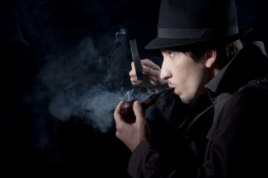 Everywhere you look, whether it be bookstores, media, television shows, or
movies, you can find some story about a detective or crime solving. These
fictional characters capture the hearts and minds of people as they race to
solve the next big case and save the world from trouble. They challenge readers
and viewers to sleuth with them and find out the clues together to figure out
the mystery or case at hand. From Sherlock Holmes to Olivia Benson, fictional
detective names have become popular. The real detectives, the real heroes behind
some of these stories, though, are often not known. Real life detectives who
have solved or help solve some of the world's greatest cases are not being
remembered or even talked about. These detectives spawned the likes of the Hardy
Boys and Nancy Drew with their courageous efforts, yet not many people even know
who they are. Everywhere you look, whether it be bookstores, media, television shows, or
movies, you can find some story about a detective or crime solving. These
fictional characters capture the hearts and minds of people as they race to
solve the next big case and save the world from trouble. They challenge readers
and viewers to sleuth with them and find out the clues together to figure out
the mystery or case at hand. From Sherlock Holmes to Olivia Benson, fictional
detective names have become popular. The real detectives, the real heroes behind
some of these stories, though, are often not known. Real life detectives who
have solved or help solve some of the world's greatest cases are not being
remembered or even talked about. These detectives spawned the likes of the Hardy
Boys and Nancy Drew with their courageous efforts, yet not many people even know
who they are.
15) The Real Sherlock Holmes?
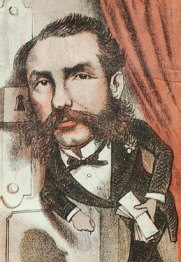 In the book "Brilliant Deduction In the book "Brilliant Deduction " by Matt Kuhns,
the author writes about several real life detectives. One of those is Ignatius
"Paddington" Pollaky, whom Kuhns calls "a true man of mysteries, in every
sense." Pollaky (1828-1918) was a Hungarian detective in London's Paddington
Green area who tracked international fugitives, spent decades working on
mysteries, and thwarted criminal deeds. He was so famous in Europe by 1880 he
was a household name and was immortalized in poems and songs. He was a private
detective who kept very much to himself. In an article published by Vaughn
Drydon in "Very Odd Fellows," Drydon says Pollaky was "sinister" enough to know
what criminals were thinking because he had acquired knowledge of how they
operate. Drydon said Pollaky was secretive about how he knew these things,
though, and stayed quiet about most subjects pertaining to himself. Just as his
name and reputation were gaining him celebrity, Pollaky retired and left the
limelight. A few years later the fictional detective Sherlock Holmes hit the
scene and all but obliterated thoughts of Pollaky. " by Matt Kuhns,
the author writes about several real life detectives. One of those is Ignatius
"Paddington" Pollaky, whom Kuhns calls "a true man of mysteries, in every
sense." Pollaky (1828-1918) was a Hungarian detective in London's Paddington
Green area who tracked international fugitives, spent decades working on
mysteries, and thwarted criminal deeds. He was so famous in Europe by 1880 he
was a household name and was immortalized in poems and songs. He was a private
detective who kept very much to himself. In an article published by Vaughn
Drydon in "Very Odd Fellows," Drydon says Pollaky was "sinister" enough to know
what criminals were thinking because he had acquired knowledge of how they
operate. Drydon said Pollaky was secretive about how he knew these things,
though, and stayed quiet about most subjects pertaining to himself. Just as his
name and reputation were gaining him celebrity, Pollaky retired and left the
limelight. A few years later the fictional detective Sherlock Holmes hit the
scene and all but obliterated thoughts of Pollaky.
14) The American Sherlock Holmes
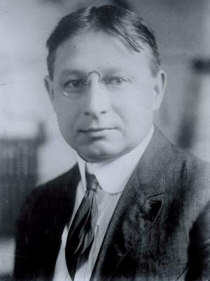 Ellis Parker (1871 – 1940) was known (among many
other names) as The Sherlock Holmes of America. Parker a rural fiddler in a
small town in New Jersey who became the detective known for solving so many
cases he was even consulted on the kidnapping of Charles Lindbergh's infant son.
Parker became so good at being a detective, he had stories written about the
crimes he solved and the small town boy became a well-traveled, and
well-respected, man, according to Kuhns. Jersey Man Magazine published an
article about Parker chronicling his career, focusing on the barn burning cases
Parker solved in the early 1900s in New Jersey. By the time the case was solved,
14 barns had burned and the criminal was found not to be a pyromaniac, but
rather a horse thief burning away evidence. It was cases like this that got
Parker the lead on the Lindbergh case, where Parker was later accused of
kidnapping and torturing an innocent man. Kuhns said this case was Parker's
attempt to end his astounding career on a high note, but the pressure of the
case drove Parker crazy and he resorted to illegal actions, ruining his
reputation. He died in prison in 1940. Ellis Parker (1871 – 1940) was known (among many
other names) as The Sherlock Holmes of America. Parker a rural fiddler in a
small town in New Jersey who became the detective known for solving so many
cases he was even consulted on the kidnapping of Charles Lindbergh's infant son.
Parker became so good at being a detective, he had stories written about the
crimes he solved and the small town boy became a well-traveled, and
well-respected, man, according to Kuhns. Jersey Man Magazine published an
article about Parker chronicling his career, focusing on the barn burning cases
Parker solved in the early 1900s in New Jersey. By the time the case was solved,
14 barns had burned and the criminal was found not to be a pyromaniac, but
rather a horse thief burning away evidence. It was cases like this that got
Parker the lead on the Lindbergh case, where Parker was later accused of
kidnapping and torturing an innocent man. Kuhns said this case was Parker's
attempt to end his astounding career on a high note, but the pressure of the
case drove Parker crazy and he resorted to illegal actions, ruining his
reputation. He died in prison in 1940.
13) The First Captain of Detectives in San Francisco
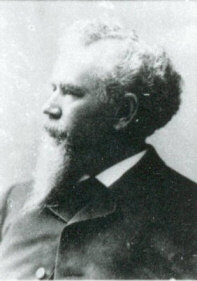 Isaiah Lees (1830 – 1902)
was the first Captain of Detectives in the San Francisco Police Department.
Author Bill Secrest wrote a biography about Lees in which he describes the way
Lees became Captain so quickly. In 1849 Lees arrived at the San Francisco Police
Department, but the department had no detectives unit. By early 1851 the local
papers were blasting the police department's efforts and saying the police were
not properly doing their jobs. Lees left the department, but in 1852 fate would
bring him back when a stabbing occurred adjacent to where Lees worked for the
Union Iron Works. Lees worked the case with friends even though he was no longer
with the department. He rejoined the force in 1853 and in 1854 the detective's
task force was established. Lees' abilities were quickly recognized and he was
put in charge of the detective unit as an assistant captain, according to Kuhns.
He was then appointed captain in 1856, but then was put back to patrolman due to
the uncertainty of the department. In 1859 he was reappointed captain, and was
then made Chief of Police in 1897. During his career Lees led a drama filled
life filled with "counterfeiting, frauds, thefts, kidnappings, and violent,
vicious murders." He was a legend in San Francisco and around the country. Isaiah Lees (1830 – 1902)
was the first Captain of Detectives in the San Francisco Police Department.
Author Bill Secrest wrote a biography about Lees in which he describes the way
Lees became Captain so quickly. In 1849 Lees arrived at the San Francisco Police
Department, but the department had no detectives unit. By early 1851 the local
papers were blasting the police department's efforts and saying the police were
not properly doing their jobs. Lees left the department, but in 1852 fate would
bring him back when a stabbing occurred adjacent to where Lees worked for the
Union Iron Works. Lees worked the case with friends even though he was no longer
with the department. He rejoined the force in 1853 and in 1854 the detective's
task force was established. Lees' abilities were quickly recognized and he was
put in charge of the detective unit as an assistant captain, according to Kuhns.
He was then appointed captain in 1856, but then was put back to patrolman due to
the uncertainty of the department. In 1859 he was reappointed captain, and was
then made Chief of Police in 1897. During his career Lees led a drama filled
life filled with "counterfeiting, frauds, thefts, kidnappings, and violent,
vicious murders." He was a legend in San Francisco and around the country.
12) The "Tailor-Made" Detective
 William J. Burns (Aug. 22, 1921 - June 14, 1924)
was a tailor from Columbus, Ohio who became a detective and loved the attention
he received from his exploits against counterfeiters, corruption, thieves, and
terrorist bombers. Burns was a "maverick" and a "frontier lawman" who often
found himself at odds with a changing and maturing world of law enforcement,
according to Kuhns. He was always involved in controversy and scandal, and ended
his long career with a tarnished name and a reputation for being a dirty
detective. Burns was born in Baltimore, Maryland and performed as a Secret
Service agent when he was young, according to the FBI's website. He took his
reputation and made the William J. Burns International Detective Agency. Burns
became a national figure due to his police work and he even made national news,
the gossip columns newspapers, and the pages of detective magazines. He was also
friends with Warren Harding’s Attorney General, Harry M. Daugherty and through
this friendship Burns was appointed Director of the Bureau of Investigation on
August 22, 1921. Under Burns, the FBI shrank its ranks by half in just three
years, and he was then asked to resign by then Attorney General Harlan Fiske
Stone because of his role in a scandal involving the secret leasing of naval oil
reserve lands to private companies. After his retirement in 1924, Burns wrote
stories about his real life cases, becoming one of the first writers to
sensationalize police work in such a way. William J. Burns (Aug. 22, 1921 - June 14, 1924)
was a tailor from Columbus, Ohio who became a detective and loved the attention
he received from his exploits against counterfeiters, corruption, thieves, and
terrorist bombers. Burns was a "maverick" and a "frontier lawman" who often
found himself at odds with a changing and maturing world of law enforcement,
according to Kuhns. He was always involved in controversy and scandal, and ended
his long career with a tarnished name and a reputation for being a dirty
detective. Burns was born in Baltimore, Maryland and performed as a Secret
Service agent when he was young, according to the FBI's website. He took his
reputation and made the William J. Burns International Detective Agency. Burns
became a national figure due to his police work and he even made national news,
the gossip columns newspapers, and the pages of detective magazines. He was also
friends with Warren Harding’s Attorney General, Harry M. Daugherty and through
this friendship Burns was appointed Director of the Bureau of Investigation on
August 22, 1921. Under Burns, the FBI shrank its ranks by half in just three
years, and he was then asked to resign by then Attorney General Harlan Fiske
Stone because of his role in a scandal involving the secret leasing of naval oil
reserve lands to private companies. After his retirement in 1924, Burns wrote
stories about his real life cases, becoming one of the first writers to
sensationalize police work in such a way.
11) One of the First Scotland Yard Detectives
 Jonathan Whicher (1814 – 1881) was
one of Scotland Yard’s first eight detectives. He was soon to be known as
London’s "original amazing detective," according to Kuhns, and was a
household name. He has had many books, plays, and even modern television shows based off
of his life and cases. Even Charles Dickens wrote about him. His reputation was
basically ruined, however, when he was assigned to a case that gained national
attention. The case involved a murdered infant, and Whicher suspected the
child's older sister of the murder. He accused her, but had no clear evidence,
as the one key piece of evidence was hidden by a police superintendent to save
face after the evidence was stolen from him. The media did not approve of
Whicher accusing the 16 year old girl, and wrote awful, damaging things about
him in the papers. Later it was discovered the girl had been the murderer when
she confessed. The girl was sentenced to death, but her confession came too
late, according to the site Metropolitan Police. Whicher's career was all but
over. The book "The Suspicions of Mr. Whicher Jonathan Whicher (1814 – 1881) was
one of Scotland Yard’s first eight detectives. He was soon to be known as
London’s "original amazing detective," according to Kuhns, and was a
household name. He has had many books, plays, and even modern television shows based off
of his life and cases. Even Charles Dickens wrote about him. His reputation was
basically ruined, however, when he was assigned to a case that gained national
attention. The case involved a murdered infant, and Whicher suspected the
child's older sister of the murder. He accused her, but had no clear evidence,
as the one key piece of evidence was hidden by a police superintendent to save
face after the evidence was stolen from him. The media did not approve of
Whicher accusing the 16 year old girl, and wrote awful, damaging things about
him in the papers. Later it was discovered the girl had been the murderer when
she confessed. The girl was sentenced to death, but her confession came too
late, according to the site Metropolitan Police. Whicher's career was all but
over. The book "The Suspicions of Mr. Whicher ," however, says that Whicher was
exonerated after the girl confessed and went back to work as a private
investigator, even playing the lead in a very big case. Whicher retired from all
police work in 1881. The girl was never executed, but did serve 20 years in
prison for her crime. ," however, says that Whicher was
exonerated after the girl confessed and went back to work as a private
investigator, even playing the lead in a very big case. Whicher retired from all
police work in 1881. The girl was never executed, but did serve 20 years in
prison for her crime.
10) The Pinkertons Create a Legacy
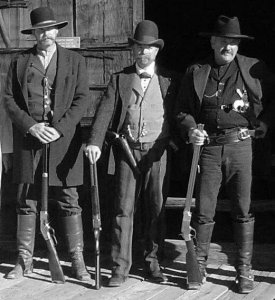 Allan Pinkerton (1819 – 1884), William
Pinkerton (1846 – 1923), and Robert Pinkerton (1848 – 1907) created a legacy on
detective work that still lives on. They formed a detective agency that would be
world known for producing some of the best detectives in the world, but their
names may not always be remembered. The Pinkertons served "as an effective
national police force in the second half of the 19th century" and fought spies
and assassins in the Civil War, according to Kuhns. They are also well-known for
their work with capturing the infamous Jesse James. They helped create the
Secret Service as well. Allan Pinkerton (1819 – 1884), William
Pinkerton (1846 – 1923), and Robert Pinkerton (1848 – 1907) created a legacy on
detective work that still lives on. They formed a detective agency that would be
world known for producing some of the best detectives in the world, but their
names may not always be remembered. The Pinkertons served "as an effective
national police force in the second half of the 19th century" and fought spies
and assassins in the Civil War, according to Kuhns. They are also well-known for
their work with capturing the infamous Jesse James. They helped create the
Secret Service as well.
The Pinkerton legend of detective work spans centuries. That may be why it is
so funny that the original Pinkerton, a poorly educated village craftsman,
became a detective through accident. He was involved with finding the culprit
behind a series of local burglaries, and that led to him being a detective full
time. Pinkerton, a very conservative man, supported abolition, women’s rights,
and radical religious views. Maybe this is why they employed the first female
detective. Kuhns said William and Robert were the sons of Allan, and were even
better detectives than their father. They have a history of tracing criminals
from remote corners of the United Sates, to Latin America, Southern America, and
Europe. They fought master thieves, murderers, and gangs. The Pinkerton Code was
created in 1850 to include not accepting bribes, never compromising, partnering
with local law enforcement, refusing divorce cases and cases that incite
scandal, turning down reward money, never raising fees without warning, and
keeping clients up-to-date on the cases, according to the Pinkerton Detective
Agency's own websites. In 1856, Kate Warne was hired by Pinkerton and becomes
the first female detective in the U.S. In 1861, the Pinkertons uncovered and
foiled an assassination plot on the life of Abraham Lincoln. During the Civil
War, Pinkerton agency served as head of the Union Intelligence Service, which
later became the Secret Service.
9) The First Female Detective
 Kate Warne was the first woman detective in the
United States, according to reports by TruTV and the Pinkertons' website. She
was hired by the Pinkertons in 1856 and started a life of legend. Warne became
supervisor of Pinkerton's Female Detective Bureau during a time when the female
division was growing, despite efforts of a jealous wife of one of the Pinkerton
brothers to stop women from being in the business. Some even accused Allan
Pinkerton, Warne's boss, of having an affair with Warne. These suspicions were
never confirmed, although it was well-known that William adored Kate. Warned
worked on hundreds of cases with the Pinkerton agency, using disguises better
than most of her male counterparts and operatives. She was one of the best
employees the Pinkertons had, and she set the bar for female detectives around
the world. Warne became seriously ill when she was 35 years old, with nothing
ever confirming why. She died, even after Allan worked hard to nurse her through
her illness. He was lost without her and missed her to the point of it sending
him into a deep depression. This is when he lost some of his abilities as a
detective and his sons took over, proving to be great at detective work. Kate Warne was the first woman detective in the
United States, according to reports by TruTV and the Pinkertons' website. She
was hired by the Pinkertons in 1856 and started a life of legend. Warne became
supervisor of Pinkerton's Female Detective Bureau during a time when the female
division was growing, despite efforts of a jealous wife of one of the Pinkerton
brothers to stop women from being in the business. Some even accused Allan
Pinkerton, Warne's boss, of having an affair with Warne. These suspicions were
never confirmed, although it was well-known that William adored Kate. Warned
worked on hundreds of cases with the Pinkerton agency, using disguises better
than most of her male counterparts and operatives. She was one of the best
employees the Pinkertons had, and she set the bar for female detectives around
the world. Warne became seriously ill when she was 35 years old, with nothing
ever confirming why. She died, even after Allan worked hard to nurse her through
her illness. He was lost without her and missed her to the point of it sending
him into a deep depression. This is when he lost some of his abilities as a
detective and his sons took over, proving to be great at detective work.
8) The Man Who Knew Guns
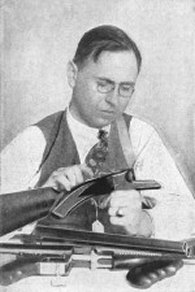 Colonel Calvin Goddard got his famous start with the
"St. Valentine's Day Massacre," when seven men were lined up against a garage
wall and murdered with machine guns. Goddard, already a famous firearms and
ballistics expert, was called in to Chicago from New York to examine the shells
and other evidence at the scene of the slaughter. He was able to determine the
men were killed by Al Capone and his mobsters dressed as police officers.
Goddard's work attracted lots of attention and a group of men made up of law
enforcement and detectives called on Goddard for help. The group saw the need
for scientific crime detection school and laboratory, and they put their money
where their ideas lay and offered the financial backing for the school. Colonel
Goddard accepted the position of director of the school and gathered groups of
experts to teach in the school. Northwestern University, the country's first
independent forensic science crime laboratory, opened in 1931. The school taught
about blood analysis, fingerprinting, and firearms. In 1932 Goddard advised the
FBI at a similar forensic science crime laboratory. Colonel Goddard is credited
with founding the science of Firearms Identification and the first example of
him using this method was during his investigation of the 1929 massacre,
according to the Goddard Award site. Colonel Calvin Goddard got his famous start with the
"St. Valentine's Day Massacre," when seven men were lined up against a garage
wall and murdered with machine guns. Goddard, already a famous firearms and
ballistics expert, was called in to Chicago from New York to examine the shells
and other evidence at the scene of the slaughter. He was able to determine the
men were killed by Al Capone and his mobsters dressed as police officers.
Goddard's work attracted lots of attention and a group of men made up of law
enforcement and detectives called on Goddard for help. The group saw the need
for scientific crime detection school and laboratory, and they put their money
where their ideas lay and offered the financial backing for the school. Colonel
Goddard accepted the position of director of the school and gathered groups of
experts to teach in the school. Northwestern University, the country's first
independent forensic science crime laboratory, opened in 1931. The school taught
about blood analysis, fingerprinting, and firearms. In 1932 Goddard advised the
FBI at a similar forensic science crime laboratory. Colonel Goddard is credited
with founding the science of Firearms Identification and the first example of
him using this method was during his investigation of the 1929 massacre,
according to the Goddard Award site.
7) The Real Fictional Detective That's Really Real
J.J. Armes is a real
detective, even if that's hard to believe. The name has become more known
through his fictional work as a detective than his actual detective work, but
Armes is a real detective. This real-life Texas private eye has a website
dedicated to his fictional work that also tells his back story. According to his
site, Armes' clients have included Elvis Presley, Howard Hughes, Elizabeth
Taylor, and Marlon Brando. Armes claims he has never lost a case.
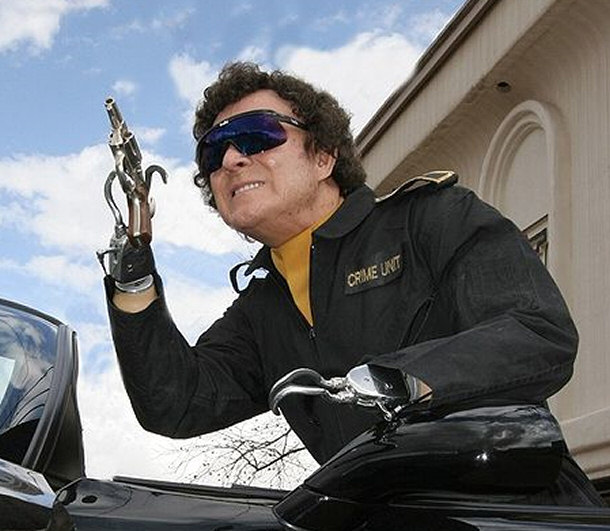
Armes'
biography was written by Frederick Nolan in 1976 and inspired a series of action
figures and TV shows. Hollywood is even now proposing to base a TV show on him.
One of the greatest things about Armes is that he has prosthetic claw hands
thanks to an accident he had when he 12 years old that resulted in his real
hands being blown off. According to Stan Lee, Armes, and Nolan Armes can do
amazing things with these claws, including reaching into fire, smashing through
doors, cutting through metal, and piloting a jet, among other things. Armes is
currently the "Chief Investigator" for The Investigators, an El Paso-based
detective agency. He is most known as an actor to people today, but his
detective work is what made him who he is.
6) A Modern Day Hero
In a letter to the editor of the New York Times written in 1996, a former
prosecutor wrote about New York City Police Detective Thomas McKenna, "who
serves as a role model to Hollywood's rookie detectives," the letter said.
Detective McKenna:

The reason the prosecutor felt this way was because of a case the prosecutor
handled after Detective McKenna solved it. The incident happened while the
detective was driving home from work at 2 a.m. one morning. The detective saw a
man running out of a parking garage on the Upper East Side, waving his arms and
screaming for help. McKenna stopped his car and the man
proceeded to tell the detective he was the garage attendant and that three men
were currently robbing the place. McKenna told the man to call the police and he
moved his car to block the entrance to the garage. He was able to stop one of
the robbers, in a stolen Mercedes, and hold him until back up arrived. McKenna
and the other police then entered the garage and found another robber. The third
was not caught until months later. During the line-up of the suspect, McKenna
refused to hide behind the two-way mirror and confronted the suspect, asking the
man if he remembered the detective. The man didn't at first, then McKenna
described what he was wearing the night of the robbery. The suspect admitted his
guilt. He is still with the department and earns more than $30,000 in overtime
pay a year as a detective, according to New York employees' website.
5) The Woman Who Catches Cheaters
 Rebecca Sutton made headlines when her real
life story of making an all-female detective agency hit the Hollywood big screen
in the form of a movie. Sutton started the agency on her own, working as a
one-woman show for hire as a private detective, according to TruTV. On her own
website Sutton said she now has a whole army of detectives working for, all
female, still of course. Most of her jobs involve following cheating spouses,
but Sutton (who also works as a model and Marilyn Monroe look-alike) says this
type of detective work is not only good pay, but good for people. Her work has
helped many women with cheating spouses, and spouses involved in illegal
activities. Not only has Sutton had women begging for her help, but also women
begging to work for her. In just six months of work, Sutton and her small crew
have caught dozens of unfaithful spouses, and the numbers are rising. A few of
their cases have even aided police in finding drug dealers and with prostitution
stings. Rebecca Sutton made headlines when her real
life story of making an all-female detective agency hit the Hollywood big screen
in the form of a movie. Sutton started the agency on her own, working as a
one-woman show for hire as a private detective, according to TruTV. On her own
website Sutton said she now has a whole army of detectives working for, all
female, still of course. Most of her jobs involve following cheating spouses,
but Sutton (who also works as a model and Marilyn Monroe look-alike) says this
type of detective work is not only good pay, but good for people. Her work has
helped many women with cheating spouses, and spouses involved in illegal
activities. Not only has Sutton had women begging for her help, but also women
begging to work for her. In just six months of work, Sutton and her small crew
have caught dozens of unfaithful spouses, and the numbers are rising. A few of
their cases have even aided police in finding drug dealers and with prostitution
stings.
4) The Detective Who Served Six Presidents
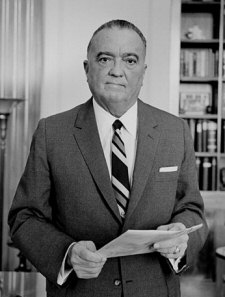 John Edgar Hoover (Jan. 1, 1895 – May
2, 1972) was the first Director of the Federal Bureau of Investigation. Hoover
was appointed director of the Bureau of Investigation in 1924 helped to found
the FBI in 1935, according to the FBI's website. He was director of the FBI
until he died in 1972 at 77 years old. Much credit is given to Hoover for
building the FBI into what it is today, and many of his practices are still
used. He worked with Goddard in developing a fingerprinting file. Under his term
with the FBI, Hoover worked for six presidents. Hoover became a controversial
figure. Hoover was known to have sex with men, but many speculate he was not a
homosexual, according to many articles (one published for ABC News). Other than
this, he has been accused of going beyond the FBI's jurisdiction, allowing the
FBI to harass protestors and people going against political figures, using
illegal methods to collect evidence, and even using the FBI as his private
police force. President Harry S. Truman even wrote that the FBI was heading in
to a "Gestapo" under Hoover. Truman asserted that all congressmen were afraid of
Hoover and would not go against him. John Edgar Hoover (Jan. 1, 1895 – May
2, 1972) was the first Director of the Federal Bureau of Investigation. Hoover
was appointed director of the Bureau of Investigation in 1924 helped to found
the FBI in 1935, according to the FBI's website. He was director of the FBI
until he died in 1972 at 77 years old. Much credit is given to Hoover for
building the FBI into what it is today, and many of his practices are still
used. He worked with Goddard in developing a fingerprinting file. Under his term
with the FBI, Hoover worked for six presidents. Hoover became a controversial
figure. Hoover was known to have sex with men, but many speculate he was not a
homosexual, according to many articles (one published for ABC News). Other than
this, he has been accused of going beyond the FBI's jurisdiction, allowing the
FBI to harass protestors and people going against political figures, using
illegal methods to collect evidence, and even using the FBI as his private
police force. President Harry S. Truman even wrote that the FBI was heading in
to a "Gestapo" under Hoover. Truman asserted that all congressmen were afraid of
Hoover and would not go against him.
3) The Rich Detective with a Biography Movie
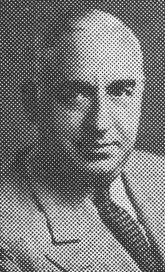 According to his biography, Raymond
C. Schindler was born in Oswego County, New York and attended High School in
Milwaukee. He was an insurance agent that began selling typewriters, then tried
his hand at gold mining in California, and then later became a detective with
the hopes of one day being a historian. His gold mining days were cut short and
he went to San Francisco in 1906 the day after the big earthquake. He got a job
as a researcher, which would be a historian one day, but he soon found the job
made him more of a detective. He would soon be assisting the San Francisco
police in investigations and then became chief lieutenant to William Burns. When
Burns started his national detective agency, Schindler became the New York
office manager. Schindler was one of the first investigators to use the
dictograph in 1911, according to multiple newspaper accounts with his obituary.
His portion of the detective agency was known as the Schindler Bureau of
Investigation in New York City, and he took control of it in. He and his work
were held in high regard by the Scotland Yard. He spent years trying to solve
the murder of Sir Harry Oakes in 1943, but it still remains unsolved. Schindler
was known to celebrate his own fame, which was plentiful, and spend lots of
money, which was also plentiful. He loved parties, fine dining, and beautiful
women. He was a regular fixture for nightclubs and restaurants. He formerly
served as president of the Adventurers Club of New York, the president of the
International Investigators, a fellow of the American Geological Society, the
British Detectives Association, and the American Polar Society. He died in 1959. According to his biography, Raymond
C. Schindler was born in Oswego County, New York and attended High School in
Milwaukee. He was an insurance agent that began selling typewriters, then tried
his hand at gold mining in California, and then later became a detective with
the hopes of one day being a historian. His gold mining days were cut short and
he went to San Francisco in 1906 the day after the big earthquake. He got a job
as a researcher, which would be a historian one day, but he soon found the job
made him more of a detective. He would soon be assisting the San Francisco
police in investigations and then became chief lieutenant to William Burns. When
Burns started his national detective agency, Schindler became the New York
office manager. Schindler was one of the first investigators to use the
dictograph in 1911, according to multiple newspaper accounts with his obituary.
His portion of the detective agency was known as the Schindler Bureau of
Investigation in New York City, and he took control of it in. He and his work
were held in high regard by the Scotland Yard. He spent years trying to solve
the murder of Sir Harry Oakes in 1943, but it still remains unsolved. Schindler
was known to celebrate his own fame, which was plentiful, and spend lots of
money, which was also plentiful. He loved parties, fine dining, and beautiful
women. He was a regular fixture for nightclubs and restaurants. He formerly
served as president of the Adventurers Club of New York, the president of the
International Investigators, a fellow of the American Geological Society, the
British Detectives Association, and the American Polar Society. He died in 1959.
2) Freedom Fighters
The Freedom Fighters are a trio of black detectives that
formed the agency to help people in their situations. The fighters have now
developed and received funding for a documentary, according to A&E TV. The
website IndieWire.com introduces the detectives. Christopher Scott was released
from prison after serving 13 years of a life sentence for a murder he didn’t
commit. Johnnie Lindsey spent 26 years in prison for a sexual assault he didn't
commit. Billy Smith was released from prison in 2006 after spending 20 years
behind bars aggravated sexual assault he did not commit. All of these cases
happened in Texas, and the fighters are working in the state to end the problem
of racism and overturn wrongful convictions.
Freedom fighters:
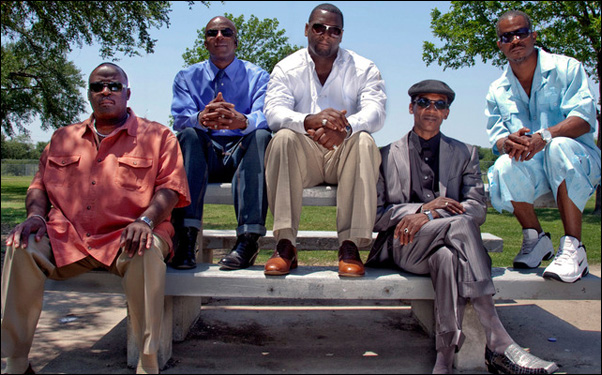
1) The First
Detective
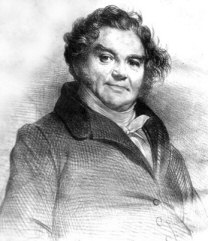 Eugène
François Vidocq (1775 – 1857) was one of the very first detectives to become
famous for what he did. This French policeman was the first full-time formal
detective and he basically invented the profession, according to author Matt
Kuhns. He has played the role of soldier, gambler, and wanted fugitive, multiple
times. Eventually he became an investigator, using his past skills to earn a
decent, honest living. Kuhns said Vidocq invented the police detective bureau,
the private detective agency, and even the detective story. Even his personal
life was full of romance, disguises, and drama. Encyclopedia Britannica said
Vidocq was an adventurer and detective "known all over France as a remarkably
audacious man." He was friends with Victor Hugo, Honoré de Balzac, Eugène Sue,
and Alexandre Dumas père, and was often ridiculed and imprisoned for his
actions. The police did not trust him, but they often needed him. He resigned
from being a detective in 1827 to start a paper and cardboard mill, which was a
failure, so he once again became chief of the detective department. He was let
go in 1832, and then created a private police agency. This, too, was soon taken
from him by the authorities, but he kept on being hired as a private
investigator by clients. Eugène
François Vidocq (1775 – 1857) was one of the very first detectives to become
famous for what he did. This French policeman was the first full-time formal
detective and he basically invented the profession, according to author Matt
Kuhns. He has played the role of soldier, gambler, and wanted fugitive, multiple
times. Eventually he became an investigator, using his past skills to earn a
decent, honest living. Kuhns said Vidocq invented the police detective bureau,
the private detective agency, and even the detective story. Even his personal
life was full of romance, disguises, and drama. Encyclopedia Britannica said
Vidocq was an adventurer and detective "known all over France as a remarkably
audacious man." He was friends with Victor Hugo, Honoré de Balzac, Eugène Sue,
and Alexandre Dumas père, and was often ridiculed and imprisoned for his
actions. The police did not trust him, but they often needed him. He resigned
from being a detective in 1827 to start a paper and cardboard mill, which was a
failure, so he once again became chief of the detective department. He was let
go in 1832, and then created a private police agency. This, too, was soon taken
from him by the authorities, but he kept on being hired as a private
investigator by clients.
Final Words
If you were to ask someone to name a detective they would probably tell you a
name like Sherlock Holmes, Columbo, Matlock, or some other fictional character.
Rarely would you hear someone say the names of The Pinkertons or Paddington
Pollaky. Yet these men (and women) have solved some of the greatest crime cases
in the history and gave birth to the fictional characters people know today.
Simple reasoning would stand to argue that these and other detectives should be
talked about, but sometimes the fictional stories over shadow the truly
interesting real life dramas. Knowing about the real life detectives that solved
the real life cases, though, can shed some insight into the way the crime world
(fictional and non-fictional) works. It's elementary, really.
History
Top Lists:
15 Biggest Architectural Blunders
Top 15 Most Horrifying Terrorist Attacks
15 Fascinating Facts About the Vietnam War
Top 15 Amazing Ancient Egyptian Architecture
20 Little Known Facts About the Titanic
Top 10 Most Creepiest Abandoned Places in the World
26 Interesting Facts About Henry Ford
List of 15 Tough Ancient Warriors Through History
List of 15 Notorious Roman Emperors and Empresses
Top 15 Worst Pandemics in History
15 Things That Remained the Same in the Past 100 Years
Top 15 Things China Invented First
Top 15 Greatest Inventors in History
15 Interesting Facts About Abraham Lincoln
10 Inventors Who Stole Their Ideas
15 Stories of Hilarious Medieval Victories
15 Detectives Credited With Solving The Biggest Cases In History
15 Fascinating Facts About the Ancient Pyramids
15 Inventions That Were the Result of a Mistake
15 Famous Stories of Execution
16 Rare Facts About the U.S. Presidency
15 Astonishing Leadership Stories that Ended up Successfully
Informational:
Analysis of the Linear B tablets and Wall Paintings
Aristophanes and Classical Greek Comedy
The First War of Scottish Independence
|